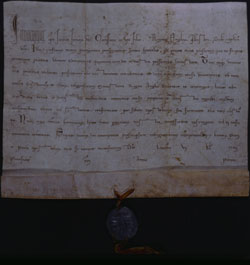 |
 |
 |
 |
 |
 |
 |
|
Rights of access (2/3) Women were not content to be kept at a distance and wanted access to the abbey churches to pray. The General Chapter responded to popular pressure and in the mid-twelfth century it was agreed that women might enter the church on the day of its dedication and the Octave. This concession did not extend to breastfeeding women.(5) The Cistercians’ official policy was not always observed. Women occasionally gained access to abbeys at forbidden times or to prohibited places, either with the compliance of an abbot or through brut force and violence. The General Chapter did not tolerate this disregard for legislation and wrongdoers were punished. Two such offenders were the prior and cellarer of Beaulieu Abbey, Hampshire, in 1246, who had served meat to guests attending the dedication of the church and permitted Queen Eleanor to stay in the infirmary for almost three weeks to tend the young Prince Edward, who had taken ill after the ceremony; they were dismissed from office. (6)
Significantly, in 1250 Innocent IV granted that noble women might enter Cistercian abbeys but were prohibited from spending the night or eating meat.(7) As far as the General Chapter was concerned, there were to be no concessions to status, or at least, any concessions simply extended to the admittance of these noble women and did not include an overnight stay. The queen of Aragon, for example, was granted special permission in 1201 to enter the Cistercian abbey of Poblet, on the day that her third son made his profession there. The royal family of Aragon had strong links with the Order and indeed the queen’s late husband was buried at Poblet where he had taken the Cistercian habit just before his death in 1196.(8) The Cistercians’ rather strict attitude at this time can be contrasted with Benedictine practice. Abbot Geoffrey of St Albans (1119-46), for example, actually constructed a chamber for the queen (9) (thalamus reginae) where she might reside when visiting the abbey; the chronicler of St Albans states that she was the only woman permitted to stay within the precinct.(10) |
||||
|
